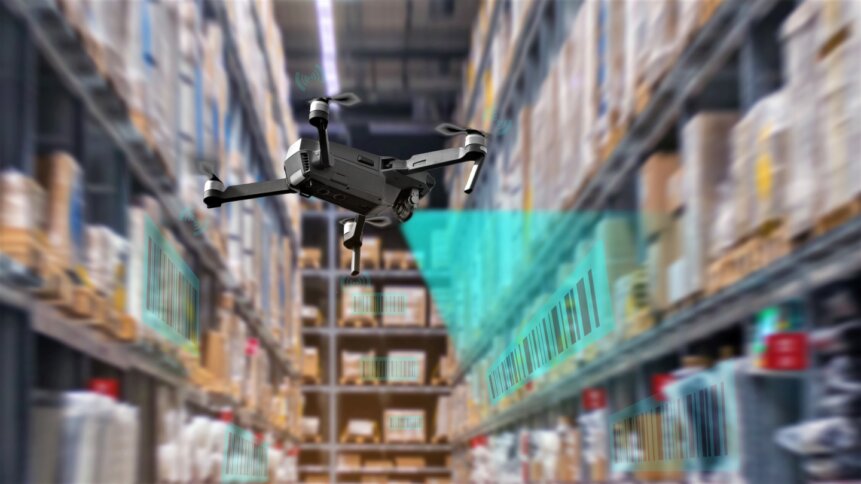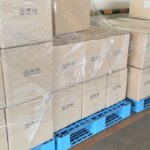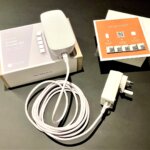Drones in supply chain management – the inside story

When it comes to the use of drones in supply chain management, you might think that last-mile delivery would be the killer app. But – as empty skies reveal – flying parcel delivery robots have yet to go mainstream. To discover where industrial drones are making their mark, you need to look inside – rather than outside – the warehouse.
Zero-error warehouse
Pilot studies such as the trial performed by Danish transport and logistics firm DSV (using self-flying inventory drones developed by Verity) have demonstrated data collection time savings of 50%. And when the technology is fully up and running, that advantage could climb to 80%. Equipment maker Verity, which has its headquarters in Zürich, Switzerland, sees drones in supply chain management as key to enabling the ‘zero-error’ warehouse.
Despite the increased use of warehouse management systems, it’s still necessary to check that what’s shown on-screen matches up with what’s found on the shelves. And for large facilities that can measure the size of multiple soccer pitches, inventory counting can take days if done manually. Recognizing that there are better ways to examine pallets of goods piled high in warehouses, Verity is one of several developers exploring the use of drones.
What’s more, as well as flying around the warehouse taking pictures of stock on the shelves, autonomous drones can record other data such as temperature and humidity. This additional information could then be integrated into alerts warning that goods may be in danger of deteriorating, reducing waste.
Time-saver
The use of drones in supply chain management can complete large inventory counts in a matter of hours rather than days if performed manually. And it saves staff from walking around giant warehouses, which can be potentially hazardous environments. Also, if you are worried about the inventory reporting robots getting in the way, the drones can fly at night when the warehouse is empty – which was the case for the DSV pilot.
Cosmetics giant L’Oréal teamed up with French firm EYESEE to modernize the inventory process at its massive warehouse complex located 10 km outside of Vichy. Again, thanks to the use of fully-automated drones equipped with cameras (with barcode recognition), the firm was able to dramatically speed up the stock counting process.
The use of drones in supply chain management reduces the number of potential shipping disruptions by improving information accuracy. But there are other advantages too. L’Oréal’s warehouse team comments that, eventually, the automated solution could eliminate the need to close the facility for an annual inventory check – a task that currently takes three days. For staff, safety is improved by using drones rather than people – considering that pallets can be stacked many shelves high. Warehouse ceilings can reach over 50 ft (15 m) to accommodate goods, giving an idea of scale.
Other driving forces for adopting inventory drone technology include addressing staff shortages. US firm Ware, another developer of inventory monitoring systems, points out that filling roles can be difficult for warehouse operators. Automation and speed of operation are central to the success of drones in supply chain management. Ware’s system uses drones provided by Skydio and follows a 3-step process.
Keeping stock of stock
Step one is data collection. Users can schedule when drone flights will take place to suit their operations, taking into account stock turnover rates. Once the inventory information has been captured, drones return to their ‘nest’ and upload the data to the cloud. AI algorithms then get to work, extracting key details that contribute to the third and final phase – the client report.
Numbers highlight how efficient systems have become. Barrett Distribution Centers, one of Ware’s customers, reports that drones can analyze 350 locations per hour compared with 20 locations per hour for manual inspection. IAG Cargo – an aviation freight specialist – found that it was spending 6,500 hours per year gathering location data by hand and reading barcodes of items inside its warehouse facilities. So, it’s no surprise to learn that the firm has also investigated aerial robotics solutions to streamline operations.
In this case, the air freight provider carried out trials using Flytbase’s drone platform, which allows developers to create and deploy fully automated and cloud-connected aerial robotics at scale. Unlike systems that operate outside, drones that fly inside have fewer regulatory restrictions, which has helped to accelerate development. Onetrack is another company that’s leveraged this opportunity.
Versatile tech stack
The firm, led by Marc Gyongyosi, built its first systems using NVIDA’s Jetson embedded computing boards, which pack GPU-powered AI capabilities into a small form factor. And he comments that being able to carry out warehouse inventory checks autonomously paves the way for a variety of other indoor services, such as security tasks and broader inspection roles.
Onetrack’s solution has its own computer vision and perception stack. As well as being part of the firm’s flying robots, the setup could equally be applied to other platforms too. And this includes the SLAM (simultaneous localization and mapping) pipeline, which provides dead reckoning for the moving devices in the absence of outdoor GPS signals.
All in all, automated inventory management has proven to be a great match for aerial robotics. And favorable return on investment figures, plus continued demand for warehouse services, can be expected to drive further growth in the market.










